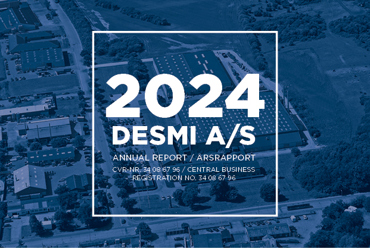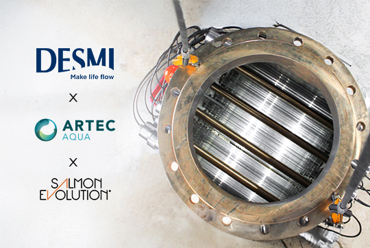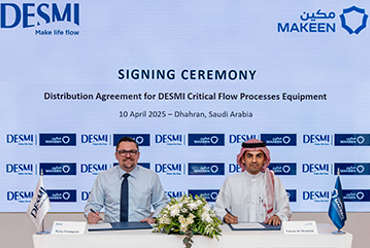
May 2025

September 2015
Pumping solutions specialist DESMI demonstrates what being the market leader in maritime helicopter fuelling systems really means.
DESMIs CSO Henrik Mørkholt Sørensen is looking very pleased. He’s standing on the deck of a naval ship, monitoring events closely as a helicopter hangs in the air just metres off the vessel’s port side, swaying gently in the relatively light easterly wind. As we watch, a line is winched down from the chopper to several crew members crouched on deck. One of the crew moves forward, using a pole to hook the line, then another, wearing brightly coloured protective gloves, assists with connecting one end of a 33-metre-long, black hose lying spread out on the deck to it.
A signal is given and the line, together with the hose, is winched up, with the deck crew helping to play the hose out as it rises. On board the helicopter, a crew member connects the nozzle of the hose to a refueling point inside the aircraft and refueling begins. Clearly, it’s a carefully planned and rehearsed operation, and the process is smoothly and successfully completed.
Vital capability
For chopper crews, hovering above deck and handling the necessary equipment can be an exciting but challenging task, particularly in difficult weather conditions. Normally, therefore, refueling takes place on deck with the aircraft properly tied down. But Helicopter In-Flight Refueling (HIFR) is a vital capability, particularly for on-going operations or missions where time is of the essence.
HIFR isn’t new, of course. Naval vessels have long had the ability to refuel helicopters while hovering just above deck – a process that typically takes around 10 minutes to complete. But it’s not just the ability to refuel in mid-air that Henrik finds interesting. Instead, it’s just how quickly and efficiently the hovering chopper is receiving clean, water-free fuel from the dangling hose.
“This hasn’t been done before,” he shouts over the deafening noise of the chopper’s spinning rotors. “We’re refueling at a flow rate of 680 litres per minute while hovering alongside.”
Record-breaker
The main task for all helicopter fuelling systems is to remove traces of water from the fuel. This is important because water is prone to accumulation due to condensation in holding tanks or settling in the pipework. If safety thresholds are exceeded, the engine’s turbines can be damaged - or it risks freezing when temperatures drop.
At 680 litres per minute, the DESMI helicopter fuelling system equipment is performing at more than twice the speed of conventional separator and pumping systems, delivering its record-breaking flow rate with sufficient pressure to reach the helicopter, but without compromising the quality of its precious cargo. By any yardstick, the DESMI solution represents the state-of-the-art in such applications, resting on its manufacturer’s lengthy history of developing pumping systems for a wide variety of contexts, many of them maritime-based.


What’s important?
What do customers prioritize in the world of helicopter refueling systems? “Not too much, not too little,” says Henrik. Helicopter refuelling needs to be performed as quickly as possible, but not at the expense of safety, quality of fuel or reliability. DESMI’s HIFR-capable system delivers clean, dry fuel at up to 680 litres per minute, in the correct quantity and quality – and at the right price, it seems, with sales growing steadily and new projects being won in Korea, Taiwan, Singapore, India and the UK despite intense competition.
Another priority is the need to have equipment occupy as little space on board as possible. DESMI has become a master in the art of the small footprint, drawing upon experience with its other maritime vessel installations – both for commercial and military applications, such as its DESMI Ocean Guard ballast water treatment systems or the OptiSave™ control and energy-optimisation solution for cooling water systems.
Safe choices
The DESMI system comprises two skids and an HIFR assembly. One, fitted near the fuel tanks in the bow, is for pumping filtration. It also houses the dispense skid, which takes care of final filtration using a liquid-to-liquid coalescer, and includes meters, hoses, reels and nozzles. The other is the HIFR skid, safely positioned on deck near the helicopter landing point.
As a starting point, all DESMI systems for aircraft fuelling include filtration certified to meet the latest API/IP 1581 standard. This ensures that very, very little water is left in the fuel – in fact, compliance with API 1581 5th edition brings water levels down to less than 10 parts per million. National safety legislation, such as ATEX for fuel systems, is taken into account if required.
“It means a lot to buyers that DESMI’s systems have been so well proven,” says Henrik. “In fact, for many we are a preferred partner for both fixed and rotary wing aircraft, as well as for ground vehicles and static equipment, too. Over the last five years, we’ve developed a fuelling system that uses our ROTAN pump as the main pumping unit, and it’s able to deliver a 200-litre per minute flow for smaller helicopters or right up to 680 litres for larger ones. The 680-litre flow we’re looking at here is an exceptional level of performance, but it’s still well within the bounds of safety and reliability. And that’s something we could never compromise on.”
Hardware headway
Installing these fuelling systems optimally is a key DESMI skill. The company’s engineers can help to determine the best approach, diagnosing any problems and discussing the challenges of integrating kit into the ship with colleagues working in many different maritime contexts.
The mechanical hardware itself is highly developed – and offers relatively few opportunities to achieve further efficiencies. Recently however, inverter electric drives have been introduced to vary the speed of the pumps, and Henrik sees this as a particular area of expertise for his company:
“Electrical control gear has become somewhat more sophisticated,” he says. “If you’re refuelling with pressure control to achieve a rate of 680 litres per minute, but you’d like to use overwing gravity refuelling, then you need to cut the speed by about half to reduce flow. It’s the same basic principle as the trigger nozzle we’re all used to using at a gas station. Our automation division is really leading in this aspect, leaning on some of the technology used in DESMI’s OptiSave™ energy-saving solution.”
Henrik turns his attention back to the action taking place aboard the ship. With the helicopter’s refuelling finally completed, the hose is disconnected and carefully winched back to the deck, the line is withdrawn, and the helicopter and its crew depart once again. The HIFR crew and Steve are left to celebrate their success and recap the process step-by-step to support the next advances in this exciting field.


May 2025

May 2025

April 2025

February 2025